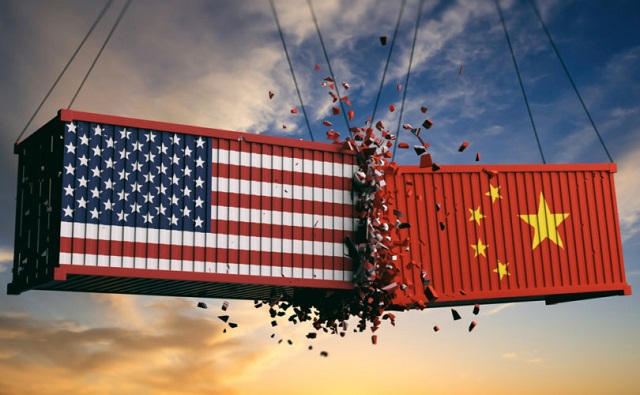conflict
Communist China makes shocking number of crucial US military equipment components: report

From LifeSiteNews
From 2005 to 2023, Chinese manufacturers in the U.S. supply chain have grown from around 12,000 to almost 45,000.
A new report details how deep the People’s Republic of China has embedded itself within the U.S. supply chain, especially for military machinery. While U.S. lawmakers have been calling for an end to this for some years, China’s domination continues unabated.
According to the report, China’s presence in the U.S. supply chain has been steadily rising for the better part of almost 20 years. From 2005 to 2023, Chinese manufacturers in the U.S. supply chain have grown from around 12,000 to almost 45,000.
The use of forced labor and dangerous working conditions gives China the ability to quickly churn out products, while keeping cost savings at a premium.
Between 2014 and 2023, the data presents a concerning trend of China outpacing U.S. supply chains across almost all industries, by 1,800 percent in some instances – including electronics, transportation, materials and chemicals, and industrial equipment.
A large number of Chinese semiconductors are used in critical military platforms, accounting for around 40 percent of all U.S. Department of Defense weapons systems and infrastructure, and are further linked to military supply chains such as Patriot air-defense missiles and B-2 bombers.
For example, a Lockheed Martin missile factory situated in Alabama produces Javelin anti-tank weapons which use more than 200 semiconductors in each weapon. This equates to thousands of Chinese-made semiconductors within U.S. weaponry.
“U.S. companies at the bottom of the supply chain pyramid often source these parts from China in open market transactions. As a result, many essential components in sensitive U.S. military systems now come from China. Countless major weapons platforms are vulnerable,” the report states.
U.S. air-launched armament supply chains also relied heavily on Chinese suppliers in 2023, according to the data. Long range anti-ship missiles, joint air-to-surface standoff missiles, naval strike missiles, Tomahawk cruise missiles, and Harpoon anti-ship missiles all used Chinese made components.
The report notes China now has a larger naval force than the U.S., with 340 new warships, and is on track to reach 400 by 2025, and 440 by 2030. Currently, U.S. Navy has under 300 warships.
Furthermore, China tops the U.S. in shipbuilding capabilities, with 17 naval shipyards in China having the ability to produce new warships, compared with five naval shipyards in the U.S.
To alleviate this, the report points out the U.S. could use its allies – which would include Japan and South Korea – to open shipyards to assist with ship production, bringing vital technology and techniques with them. However, the report states the U.S. government is reluctant to invest more funding into ship manufacturing.
Some state leaders are fighting back against this trend. In January, Florida Gov. Ron DeSantis announced the Sunshine State will invest over $380 million into semiconductor manufacturing. Over $100 million will be focused on developing Florida’s semiconductor “talent-pipeline” with significant investment into state colleges and universities, including the University of Florida’s Semiconductor Institute.
“Industries like semiconductor manufacturing and advanced packaging support our national security and create economic opportunities in our state,” DeSantis said in a statement from his office.
WND contacted GOP members of the Committee on Homeland Security and Governmental Affairs about the report on Chinese made military components, but did not receive a response at the time of publishing.
Reprinted with permission from the WND News Center.
Artificial Intelligence
AI Drone ‘Swarms’ Unleashed On Ukraine Battlefields, Marking New Era Of Warfare


From the Daily Caller News Foundation
Artificial intelligence-powered drones are making their first appearances on the battlefield in the Russia-Ukraine war as warfare creeps closer to full automation.
In bombardments on Russian targets in the past year, Ukrainian drones acting in concert were able to independently determine where to strike without human input.
It’s the first battlefield use of AI “swarm” technology in a real-world environment, a senior Ukrainian official and Swarmer, the company who makes the software, told the Wall Street Journal in a Tuesday report. While drones have increasingly defined modern battlefields, swarms until now had been confined to testing rather than combat.
“You set the target and the drones do the rest,” Swarmer Chief Executive Serhii Kupriienko told the WSJ. “They work together, they adapt.”
So far, the Swarmer technology has been used hundreds of times to target Russia assets, but was first used a year ago to lay mines on the front, the Ukrainian official told the WSJ. The software has been tested with up to 25 drones at once, but is usually utilized with only three.
Kupriienko told the WSJ that he was preparing to test up to 100 drones at once with the linking software.
A common arrangement used on the battlefield includes one reconnaissance drone to scout out the target and two explosive drones delivering the payload on target, the official told the WSJ.
While Western nations such as the U.S., France and the United Kingdom are also pursuing drone swarm technology, they have not deployed swarm technology on the battlefield the way Ukraine has, according to the WSJ. Currently, autonomous weapons are not regulated by any international authority or binding agreement, but ethical concerns around the technology has led many to call for increased regulation of weapons like the Swarmer system.
The Ukrainian Ministry of Foreign Affairs did not immediately respond to the Daily Caller News Foundation’s request for comment.
conflict
Trump Pentagon Reportedly Blocking Ukraine From Firing Western Missiles Deep Into Russia


From the Daily Caller News Foundation
The Department of Defense has spent months blocking the Ukrainian military from using American and British-made missiles to hit targets deep inside Russia, The Wall Street Journal reported Sunday, citing unnamed U.S. officials.
Undersecretary of Defense for Policy Eldridge Colby reportedly designed the procedure to review requests to carry out the long-range strikes with weapons that are either of U.S. origin or that require American intelligence or use components provided by the U.S., according to the WSJ. Secretary of Defense Pete Hegseth reportedly has the final say on whether Ukrainian forces can use the MGM-140 ATACMS (Army Tactical Missile System) to hit targets in Russia.
The reported blocks on missile strikes coincides with a Trump administration effort to broker a peace deal between Russia and Ukraine. A Pentagon spokesperson declined to comment further on the matter.
BREAKING: President Vladimir Putin reacts to B-2 Flyover pic.twitter.com/1mzVn7DxlW
— Jack Poso 🇺🇸 (@JackPosobiec) August 15, 2025
The Biden administration allowed Ukraine to carry out strikes with ATACMS in November, weeks after President Donald Trump won the 2024 election, the New York Times reported. Trump criticized the move during a December interview with Time magazine.
“It’s crazy what’s taking place. It’s crazy,” Trump said. “I disagree very vehemently with sending missiles hundreds of miles into Russia. Why are we doing that? We’re just escalating this war and making it worse. That should not have been allowed to be done.”
Trump and Russian President Vladimir Putin met in Alaska on Aug. 15 for a summit meeting during which Trump sought to secure a cease-fire in Russia’s war with Ukraine. As Trump greeted Putin, a B-2A Spirit stealth bomber and several fighters carried out a flyover of Elmendorf Air Force Base.
Trump met with Ukrainian President Volodymyr Zelensky and major European leaders on Aug. 18 to update them on the summit.
In July, Trump reached an agreement with NATO where members of the alliance would purchase weapons, including MIM-104 Patriot surface-to-air missiles, and donate them to Ukraine.
-

 International2 days ago
International2 days agoGeorgia county admits illegally certifying 315k ballots in 2020 presidential election
-

 Haultain Research2 days ago
Haultain Research2 days agoSweden Fixed What Canada Won’t Even Name
-

 Business2 days ago
Business2 days agoWhat Do Loyalty Rewards Programs Cost Us?
-

 Energy2 days ago
Energy2 days agoWhy Japan wants Western Canadian LNG
-

 Business2 days ago
Business2 days agoLand use will be British Columbia’s biggest issue in 2026
-

 Business2 days ago
Business2 days agoThe Real Reason Canada’s Health Care System Is Failing
-

 Business2 days ago
Business2 days agoDark clouds loom over Canada’s economy in 2026
-

 Business2 days ago
Business2 days agoFederal funds FROZEN after massive fraud uncovered: Trump cuts off Minnesota child care money



